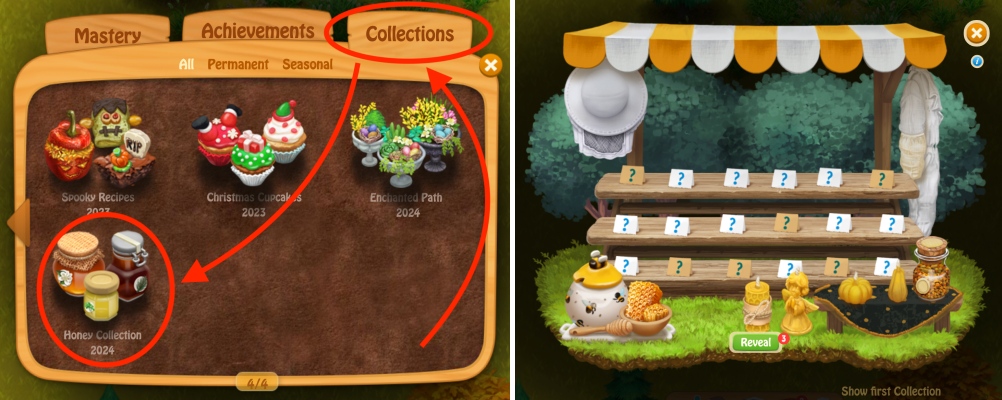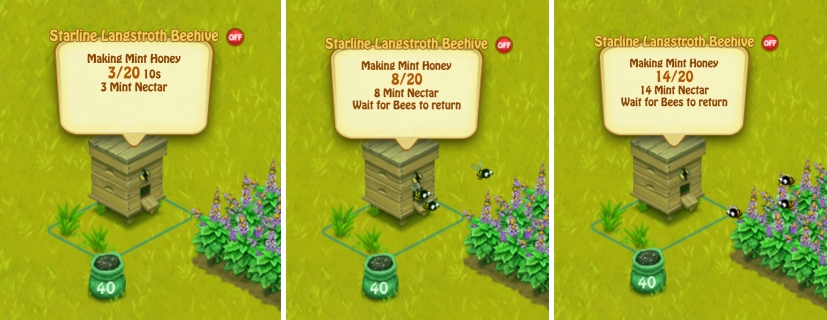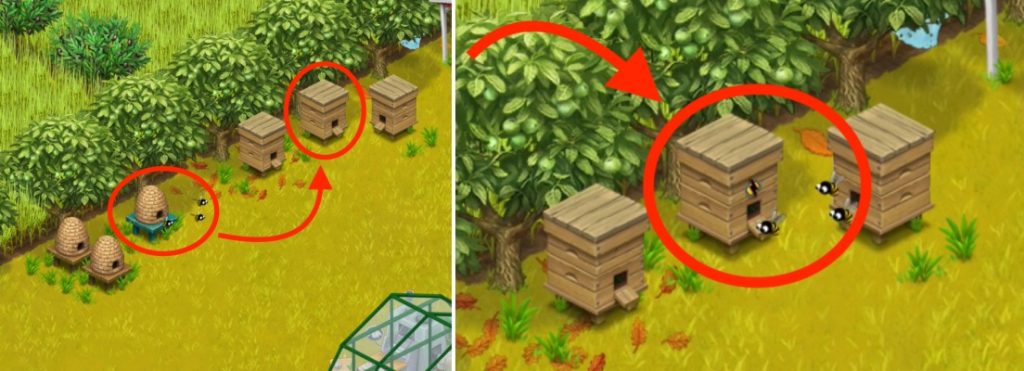Honey Making Cheat Sheet
To get the honey type you want and finish the Collection:
- Place one Beehive in a corner near 20 empty Plots (or Shrub Beds, for the Blueberry Honey).
- Harvest everything on your farm and don’t plant new Crops.
- Plant 20 of the Crop you want Honey from next to the Beehive, or move one type only of the 5 pollinable trees (Chestnut, Orange, Avocado, Pine, Cherry) next to it.
- Use Weak Fertilizer to grow the plant to the right stage (see plant in Shop).
- Let the Bees pollinate. Done!
Tips:
- If you think you can manage it, to complete the Contest faster, place Beehives in opposite corners of the farm, and let each one work on a separate type of Honey.
Other details, in short
The Langstroth Beehive shows a radius after hovering over it for more than 2 seconds. Bees can pollinate any of the 17 pollinable plants within this radius, provided the plants are in their pollinable growth stage.
- Crops and Trees have 5 growth stages — some can be pollinated on growth stage 2, some 4, some 5 (fully grown). Herbs have 4 growth stages, while Blueberries are a bit more complicated (more on that below). You can either wait for a plant to reach its pollinable stage or use Weak Fertilizer, which you can get in Daily Rewards or the Shop. Each use of the Weak Fertilizer grows a plant by one growth stage.
- Bees must pollinate 20 plants and collect 20 Nectar to produce 1 jar of Honey, containing 20 Honey Portions. Only 1 jar of each Honey type is needed for the Collection. The first jar for each type goes to the Collection, not the Barn. If 3 or more Nectar come from a different plant than the main one, they will produce Polyfloral Honey.
- Using the Langstoth Beehives requires skill and strategy, so be mindful of what and where you plant, and where your Beehives are.
- Automation only collects the Honey Jar for 1 OP; it does not affect the Bees’ departure from the Beehive.
Now, we’ll go into more details.
What Honey type to make / Make the Collection again
Go to your Collections tab and open the Honey Collection 2024.

You will notice 18 signs with question marks on them, each representing a different Honey type.
The 12 white signs with a question mark indicate a Honey type from the Regular Honey Collection. The 6 golden signs with question marks indicate a type that’s required for the Premium Collection. This collection includes all 12 types from the Regular Collection, plus these 6 additional types. Hover with your mouse cursor over one to see what Honey type it is.
Each Honey type requires the Bees to pollinate 20 of that specific plant and return with 20 Nectar to the Beehive.
In the Shop, you can check what plants can be pollinated by looking for the pollen icon. You can also click on a crop to see the growth stage at which it has pollen — and it will be pollinable during that stage only.

Right image: where to check at what stage the plant is ready for Bee pollination.
So, in this example, Mint can be pollinated ONLY in stage 4 out of 5.
Crops and Trees have 5 growth stages, with 1 being seeds and 5 the fully grown plant. As a reference, Clover was pollinable starting from stage 4, as well as at stage 5. For Herbs, 4 is the last growth stage (they only have 4).
There are also new Filtering options in the Shop to only see the Seeds or Trees that are Pollinable.

Now, where to plant Mint… Hover your mouse cursor over a Langstroth Beehive for 2 seconds, and a circle will appear, indicating the area (or range) where the Bees can pollinate plants.

What to consider
Keep in mind that Bees can pollinate ALL plants in the the Langstroth Beehive’s radius, so take this into consideration to avoid making unwanted types of Honey. If you want to make Mint Honey (for example), then make sure Mint is the only pollinable plant in the highlighted area. If Bees return with 3 or more pollen from plants other than Mint, they will make Polyfloral Honey.
We also recommend you place only 1 Langstroth Beehive in that area. Otherwise, when the plants reach the pollination growth stage, the Bees in al 3 will fly to pollinate.
Making the Honey
Let’s continue with the Mint Honey example. When Mint reaches stage 4, the Bees will pollinate it. All the plants that have pollinable stages indicate what stage they’re in on hover.
Plant 20 Mint crops in an isolated area on the Farm and click 3 times with the Weak Fertilizer to reach growth stage 4 for Mint (seeds are stage 1).

After the Bees pollinate the plant, it will show some yellow/orange spots to let you know it’s pollinated — like Clover.
Keep fertilizing the other plots 3 times so they reach growth stage 4 for Mint, too, and the Bees will keep doing their job.

Once the Bees have 20 Mint Nectar, they will finally produce 1 Mint Honey. Note the first Honey for each type DOES NOT go to your Barn because it is used for the Collection. Only 1 jar of each Honey type is required for the Collection. Also, Bees must have at least 18 Nectar of the Honey type you want to make in order to make that type.
Regular Collection and Premium Collection
The Regular Collection can be completed by making all 12 Honey types under the white signs with a question mark. This collection doesn’t require plants bought with RC, is accessible to everybody to make, and it is the only one required to complete the Contest and keep the Langstroth Beehives and Beekeeper’s Stall forever. Only 1 jar of each Honey type is required for the Collection.
The Premium Collection is the Regular Collection plus the 6 Honey types under the golden signs with a question mark. So, Premium Collection means all 18 Honey types. You can create a Premium Collection by making all Honey types. Adding the Regular Collection to the Barn will reset your progress.

For this event, all Honey types can be crafted by players who are level 22 and above. To help you complete the event, we’ve temporarily lowered the required level for plants normally unlocked above level 22.
Here is a list of Honey types and the levels at which they will be available once the Autumn Event 2024 ends:
Regular Collection
- Clover Honey — Level 1
- Cherry Honey — Level 9
- Blueberry Honey — Level 12
- Pine Tree Honey — Level 16
- Orange Blossom Honey — Level 17
- Polyfloral Honey — Level 20
- Alfalfa Honey — Level 22
- Avocado Honey — Level 36
- Yellow Rose Honey — Level 36
- Mint Honey Honey — Level 37
- Thyme Honey — Level 42
- Sage Honey — Level 75
Required extra for the Premium Collection
- Snowdrops Honey — Level 22
- Crocus Honey — Level 28
- Rosemary Honey — Level 37
- Pink Rose Honey — Level 53
- Sunflower Honey — Level 84
- Chestnut Honey — Level 113
What plants can be pollinated and at what stage?
Crops and Trees have 5 growth stages — some can be pollinated on growth stage 2, some 4, some 5 (fully grown). Herbs have 4 growth stages, while Blueberries (shrubs) are a tad harder to figure out.
Here are the plants that can be pollinated to produce the new types of Honey, based on the type of plant and the pollination stage (shown in brackets).
- Crops: Clover (4), Alfalfa (5), Snowdrops (5), Crocus (5), Yellow Rose (5), Mint (4), Pink Rose (5), Sunflower (4)
- Trees: Cherry Tree (2), Pine Tree (4), Orange Tree (2), Avocado Tree (2), Chestnut (2)
- Herbs (Herbs Garden): Rosemary (4), Thyme (4), Sage/Purple Sage (4)
- Shrubs: Blueberries (5). This is stage 2 after the Shrub matures.

Please note once again that plants will only be pollinable during that specific growth stage. So, you have to either wait for the plant to reach stages 2, 4, or 5, or use the Weak Fertilizer that grows a plant by 25% with each click. Weak Fertilizer can be obtained from Daily Rewards, or bought from the Shop > Specials tab.
Polyfloral Honey
Polyfloral Honey requires 20 Nectar from plants and it’s created when Bees collect Nectar from a main plant plus 3 or more units of any other plants combined. So, to make Polyfloral Honey, you will have to “screw it up” and make the Bees pollinate and get Nectar from multiple plants.
Here are some examples of Nectar combinations:
- 19 Alfalfa, 1 Cherry — Not Polyfloral (it will be Alfalfa Honey)
- 18 Alfalfa, 2 Cherry — Not Polyfloral (it will be Alfalfa Honey)
- 17 Alfalfa, 3 Cherry — Polyfloral Honey
- 17 Alfalfa, 2 Cherry, 1 Rosemary — Polyfloral Honey
- 17 Alfalfa, 1 Cherry, 1 Rosemary, 1 Yellow Rose — Polyfloral Honey
- 16 Alfalfa, 4 Blueberries — Polyfloral Honey
“Nothing to Pollinate”
The Beehives have a Zzz animation showing above when they don’t have something to pollinate in their area, so you don’t think they’re stuck. They also display a “Nothing to pollinate in the area” message if you hover over them. You can click the Beehive to disable the Zzz animation.

FAQ
How do I add Bees to a Langstroth Beehive?
The Beehive arrives empty. To add Bees, first click on one of your Langstroth Beehives, then click on a Starline Bee Skep, or regular Bee Skep, on your Farm.

… and some magic will happen, the Bees will fly from the Starline Bee Skep (or regular Bee Skep) to the Langstroth Beehive.

You can transfer Bees between Beehives and Bee Skeps very easy, so don’t worry about adding regular Bees by mistake.
What happens to Bee Skeps? Can they make the new Honey?
The Bee Skeps work just as before, making Clover Honey. They cannot make the new Honey types. Empty Bee Skeps or empty Langstroth Beehives do not count towards your Limits for Animals.
Can I turn Automation OFF for the Langstroth Beehives?
Yes, but keep in mind Automation only collects the Honey jar when it’s ready. Bees automatically get out of the Beehive if they have something to pollinate in the Beehive’s radius.
Also, this means Bees use 20 times fewer OPs to get 1 jar of Honey. Previously, it was 20 OPs to collect 20 Honey, now it’s 1 OP to collect 1 Honey jar that has 20 Honey Portions.
I can’t move the Bees back to an empty Bee Skep/Beehive!
To move the Bees back to an empty Bee Skep from a Beehive (or vice versa), the Bees have to finish making the Honey in their current home first (so, to have 0 Nectar), and you have to collect the Honey jar. Then you can move them.
How can I control the Bees in Langstroth Beehives?
You can control the Bees by watching what you plant in their radius, move the Beehives away, or temporarily move the Bees back to Bee Skeps (if the Langstroth Beehive hasn’t collected any Nectar to make Honey).
What’s with the new Honey and Honey (deprecated)?
When you logged on the game after the Autumn Event started, you got an Info notice like this, informing you that Honey (deprecated) was transformed into Clover Honey.
Note that you have the same number of Honey Portions of Clover Honey as you had in Honey jars before — because 1 Clover Honey jar has 20 Honey Portions. If a product used 1 Honey before, now it uses 1 Honey Portion.

and now it’s 16,560 Honey portions.
This allows a jar of Honey to feel much more precious and hard to obtain, even if, with the new Honey portions, right now it’s the same as before, without you having to do anything.
What are the advantages of the New Honey?
First, it solves multiple issues, first by is taking pressure off the Clover > Cow > Milk > Cheese chain, by both:
- making the Goats eat Alfalfa.
- using other types of Honey for your Recipes, by allowing to transform any type of Honey into an opened honey jar (Honey Portions), in increasing price order, with the new portions system. (feature coming soon, right now they’re using only the Clover Honey).
Further pressure is relieved from the Clover pollination chain, by making some recipes use Sugar instead of Honey. Sugar also has a Portions system.
20x less OP (for now), because the Beehives use OP only when they pick up the Honey. This event happens now 20 times less.
Will I still need Floral Essence Vials after the Event ends?
Bees in Langstroth Beehives no longer require Floral Essence Vials after the Autumn Event 2024 ended.
How can I customize my Langstroth Beehive?
Langstroth Beehives are very customizable, so you can customize each one to your liking (comings soon).
